In the weeds
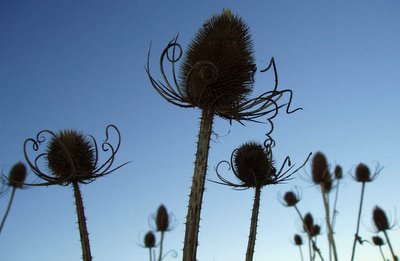 There's been a merger going on at work. Tuesday morning the final results were announced and the end result is that a number of folks are going to be laid off round the company. Our site got off relatively easy, but this stuff is never fun, and we are a small, tightly knit operation. By 12.30, everyone had retired to the pub to drown their sorrows. Over the next six months, we're going to be saying farewell to 7 staff.
There's been a merger going on at work. Tuesday morning the final results were announced and the end result is that a number of folks are going to be laid off round the company. Our site got off relatively easy, but this stuff is never fun, and we are a small, tightly knit operation. By 12.30, everyone had retired to the pub to drown their sorrows. Over the next six months, we're going to be saying farewell to 7 staff.
I'm not a big drinker, so I said my cheers and took advantage of the late afternoon light to take some photos out at Boulder Reservoir. One was the sunset photo I posted on Wednesday.

Most of these shots are just random weeds and landscapes, things that I find interesting. I've done some effects work on some of them, mostly just shooting for experimentation's sake.
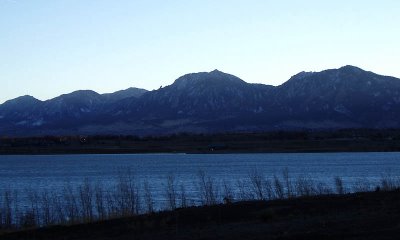
Reconnaisance via bicycle is quite possibly the best way to find good photo opportunities in any locale. You become so much more aware of your surroundings. You're going slow enough to actually see the details in the landscape, but not so slowly that you aren't continually re-inspired by something new around the next corner. You have a complete 360-degree view of your surroundings, unfettered by windows, and uninsulated from the sights, sounds, smells and excitement of it all. Every time I got on a bike, even before I had a camera, I was always framing shots in my mind, saying to myself, 'wow, that sure would be cool to have a picture of'.
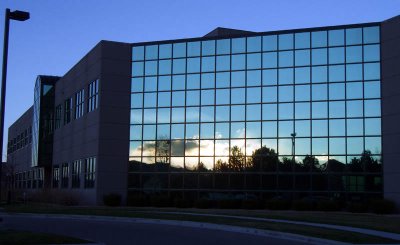
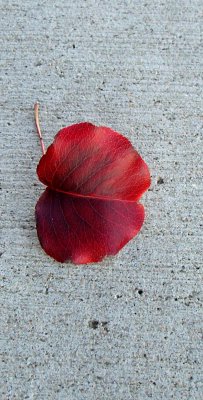 I was big into art as a kid. I drew constantly and got pretty heavily into charcoal, inks and watercolours as a teen. For various reasons, I left it all behind and no longer pursue those particular outlets, but photography has really re-awakened the creative drive within me.
I was big into art as a kid. I drew constantly and got pretty heavily into charcoal, inks and watercolours as a teen. For various reasons, I left it all behind and no longer pursue those particular outlets, but photography has really re-awakened the creative drive within me.Zen meditation teaches a student to focus by striking a bell or gong, then listening to the sound as it dies to nothing. When is the exact moment between resonance, and silence? When I'm behind the lens, framing a shot, I'm caught in that moment.
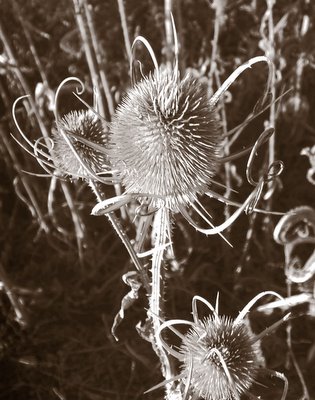
One of the joys of photography is that, while yes, there are plenty of mistakes you can make, and techniques you can use, there is no exact 'right' way to do things. Digital photography and digital editing software completely frees one of the concern with wasting expensive film. You can shoot whatever you see that you like, delete it if it didn't work, and go on. You are free to experiment wildly and at random. These next few shots are examples of testing the parameters a bit.
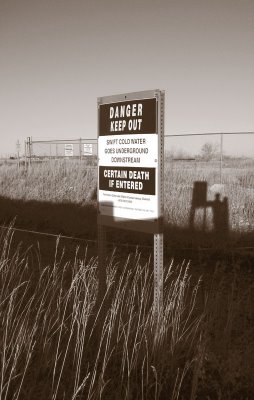 This 'Certain Death' sign is out on one of my favourite cyclocross routes thru the rez. The canal catwalk goes across a small, narrow, rickety bridge with a couple of good ledges on and off, and a skinny bar-width squeeze past a tank on the east end. The local cycling cognoscenti refer to the assemblage as 'Certain Death', naturally. If I'm having a particularly good mojo day, I can ride it in both directions.
This 'Certain Death' sign is out on one of my favourite cyclocross routes thru the rez. The canal catwalk goes across a small, narrow, rickety bridge with a couple of good ledges on and off, and a skinny bar-width squeeze past a tank on the east end. The local cycling cognoscenti refer to the assemblage as 'Certain Death', naturally. If I'm having a particularly good mojo day, I can ride it in both directions.A topic of recent debate is: should you shoot full colour, then manipulate in Photoshop, or use the camera software to take the shot as a fully evolved B&W or sepiatone?
After discussing this with several pro photogs I know, I've reached my conclusion: I prefer to shoot full colour, have all the information in the raw file, and use Photoshop to achieve what I'm looking for. It was pointed out that you can always throw information out, but you can't bring it back if it's not there to begin with.
I prefer the control and adjustability of doing these as duotones in Photoshop. I like these darker, chocolatey 'ferrotype' sorts of results I get from doing this, as opposed to the rusty oranges of the sepia mode in most cameras.
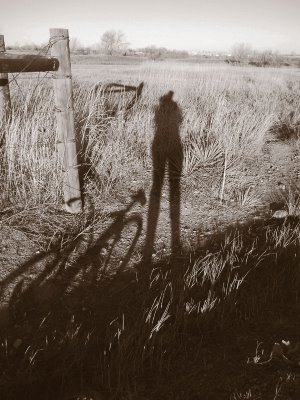
.
.
.
.
.
.
.
.
.
.
.
.
.
.
.
.
.
.
.
.
.
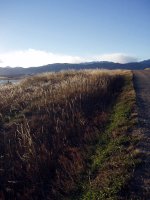
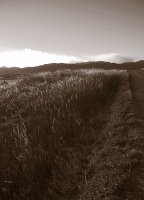
.
.
.
.
.
.
.
.
.
.
.
The 2 versions here are good examples of a shot that I thought might translate well into a duotone, but the end result looks better in full colour. I thought the duotone might bring up the highlights in the silvery backlit grass. However, running a fairly straightforward 'high pass filter' in Photoshop, achieves better results in the colour file.
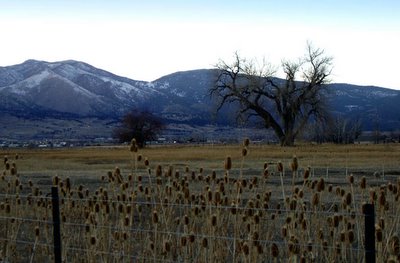
This shot illustrates why I really want a DSLR. It's very difficult to shoot exactly what the human eye sees, particularly in failing light such as this with a bright sky as backdrop. However, with manual control of exposure / aperture, I feel I could have gotten this shot to be much less murky and the 'pasture sentinels' (large solitary cottonwoods) would have come up in better detail.
Tuesday was freezing cold, howling wind and I was bundled up like the Michelin Man. I had a hard time taking some of these shots, because the wind was blowing so hard that it was blowing ME around... between my (normally) shaky hands, shivering in eighteen degrees windchill, and getting buffeted by huge gusts, it made for interesting times. Shooting with gloves on is a complete non-starter, especially with a fiddly little compact digicam. Shooting with gloves off, is bloody painful in that sort of cold.
Last but not least, the sunset shot I posted on Wednesday, with an explanation, and a modified version that I photoshopped.
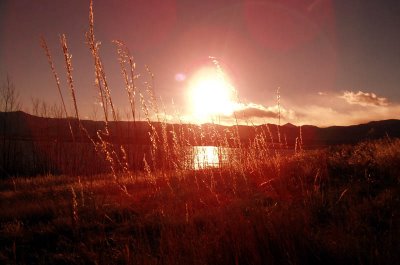
This shot broke a lot of rules, and still turned out pretty neat. Shooting straight into the sun, isn't a very brilliant idea, but with an LCD viewfinder, you can get away with it without sacrificing your eyesight. For this shot, I really wanted the details of the feathery, backlit grass. The challenge was that shooting straight into the vivid setting sun, blew out everything to the point where all you could see was faint mountain shadows. I really needed some sort of polarising filter, and with a fixed lens point-and-shoot, that's not going to happen very easily.
Lens flare is a simple by-product of shooting directly towards a bright light, i.e. the sun, sometimes exacerbated by a dirty lens (I'm not so good about checking that stuff). It can be an asset or a flaw, depending on the placement and what details of the composition are obscured by the flare.
Pro photographers often use filters to provide clarity or colour cast to a shot. Black and white film is often shot using a red filter to sharpen detail.
Whilst trying to solve how to get this shot, I decided to experiment with holding my Rudy Project sunglasses in front of the lens. I had the Racing Red lenses installed, and the tricky part was finding a spot on the sunglass lenses that was free of scratches, smear and dirt clods. As you can see the results were pretty cool.
The shot could technically be much, much cleaner. A tripod, or even monopod, is really essential for most landscape photography to capture clean details. The depth of field and focal point are mediocre, but that's a hallmark of fully-auto point-and-shoot convenience. The midtones are underexposed, the composition isn't what it could be, and the horizon could be straighter. But the dual lens flare is nifty, and the strong rose colour cast provided by the sunglasses, makes for an interesting photo.
Here's another version, that's been run through Photoshop and had the strong red colour cast removed, so that it simply looks as if I used a polarising filter.

The key to photography, for me, personally, is that every so often it gives me the power to promote the mundane into the transcendent.
Cheers,
LFR
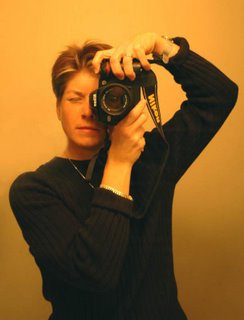

0 Comments:
Post a Comment
<< Home